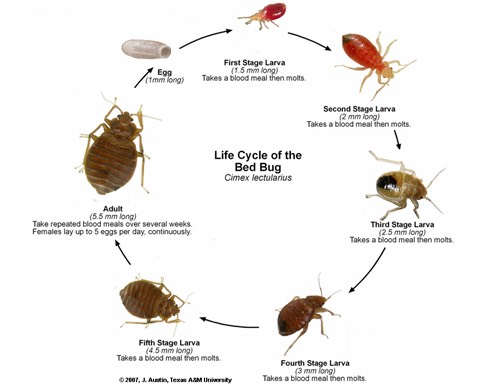Texas Bed Bugs
Have you been in the dark? Bed Bugs are back! In this article I will provide you with some photos and some basic information on who is at risk and what you can do to help prevent them from visiting you. With these critters prevention starts with cautious actions and preventative habits on your part.

(Left) If you seen this pest (the Bed Bug) then you probably have a story or two to tell.
 (Right) The Life cycle of the bed bug, starting from the top left, moving counterclockwise: eggs (1mm), 1st stage nymph (1.5 mm), 2ndstage nymph (2 mm), 3rd stage nymph (2.5 mm), 4th stage nymph (3 mm), 5th stage nymph (1.5 mm), unfed adult (5.5 mm), and fed adult. Photo Courtesy of Stephen Doggett, Department of Medical Entomology, Westmead Hospital, Sydney, Australia
(Right) The Life cycle of the bed bug, starting from the top left, moving counterclockwise: eggs (1mm), 1st stage nymph (1.5 mm), 2ndstage nymph (2 mm), 3rd stage nymph (2.5 mm), 4th stage nymph (3 mm), 5th stage nymph (1.5 mm), unfed adult (5.5 mm), and fed adult. Photo Courtesy of Stephen Doggett, Department of Medical Entomology, Westmead Hospital, Sydney, Australia
Life Cycle

Before it's first blood meal the first stage larva is clear to white in color and almost hard to see and detect normally they will be clustered together and will be easer to spot. If you have a headboard attached to your bed look in the cracks/crevices and on the back of it. They react to the carbon of your breath.
Common Bed Bug Myths
Myth: You can’t see a bed bug.
Reality: You should be able to see adult bed bugs, nymphs and eggs with your naked eye.
Myth: Bed bugs live in dirty places.
Reality: Bed bugs are not attracted to dirt and grime; they are attracted to warmth, blood and carbon dioxide. However, clutter offers more hiding spots.
Myth: Bed bugs transmit diseases.
Reality: There are no cases that indicate bed bugs pass diseases from one host to another. Lab tests have shown that it is unlikely that the insect is capable of infecting its host.
Myth: Bed bugs won’t come out if the room is brightly lit.
Reality: While bed bugs prefer darkness, keeping the light on at night won’t deter these pests from biting you.
Myth: Pesticide applications alone will easily eliminate bed bug infestations.
Reality: Bed bug control can only be maintained through a comprehensive treatment strategy that incorporates a variety of techniques and vigilant monitoring. Proper use of pesticides may be one component of the strategy, but will not eliminate bed bugs alone. In addition, bed bugs populations in different geographic areas of the country have developed resistance to many pesticidal modes of action. If you're dealing with a resistant population, some products and application methods may only serve to make the problem worse. It is a good idea to consult a qualified pest management professional (PMP) if you have bed bugs in your home.
Bed Bug Biology
The common bed bug (Cimex lectularius) has long been a pest – feeding on blood, causing itchy bites and generally irritating their human hosts. Knowing what to look for is the first step in controlling bed bugs. Generally, adult bed bugs are 1/4 to 3/8 inch (4-5mm) long, brown in color, with a flat, oval-shaped body; while young bed bugs (also called nymphs) are smaller and lighter in color. (See above photos)
When not feeding, bed bugs hide in a variety of places. Around the bed, they can be found near the piping, seams and tags of the mattress and box spring, and in cracks on the bed frame and head board.
If the room is heavily infested, you may find bed bugs in the seams of chairs and couches, between cushions, in the folds of curtains, in drawer joints, in electrical receptacles and appliances, under loose wall paper and wall hangings -- even in the head of a screw. Since bed bugs are only about the width of a credit card, they can squeeze into really small hiding spots. If a crack will hold a credit card, it could hide a bed bug.
Preventing Bed Bug Infestations
Bed bugs are very successful hitchhikers, moving from an infested site to furniture, bedding, baggage, boxes, and clothing. Although they typically feed on blood every five to ten days, bed bugs can be quite resilient; they are capable of surviving over a year without feeding.
A few simple precautions can help prevent bed bug infestation in your home:
- Check secondhand furniture, beds, and couches for any signs of bed bug infestation, as described above before bringing them home.
- Use a protective cover that encases mattresses and box springs which eliminates many hiding spots. The light color of the encasement makes bed bugs easier to see. Be sure to purchase a high quality encasement that will resist tearing and check the encasements regularly for holes.
- Reduce clutter in your home to reduce hiding places for bed bugs.
- When traveling:
- In hotel rooms, use luggage racks to hold your luggage when packing or unpacking rather than setting your luggage on the bed or floor.
- Check the mattress and headboard before sleeping.
- Upon returning home, unpack directly into a washing machine and inspect your luggage carefully.
Hiring Pest Management Professionals
Getting a pest management professional (PMP) involved as soon as possible rather than taking time to try to treat the problem yourself, they are very effective at preventing further infestations. Each pest management company should have instructions for residents on how to prepare the unit for treatment which will include laundering and cleaning.
The PMP will inspect your residence, take apart furniture if necessary.